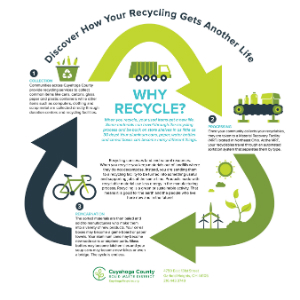Reduce, Reuse, Recycle
Learn the meaning and actions of reduce, reuse and recycle.

Everyone knows or has heard about the three Rs. But what do they really mean??
When we talk about the waste we generate and how it's managed, these terms are listed in order of priority. Let's take a look at each term individually.
Reduce
The practice of using less material in the first place, resulting in a smaller amount of waste.
Reduction is priority #1. Use less stuff, decrease your consumption, and minimize your waste footprint. Ultimately, garbage is buried in a landfill and never used again. Deciding to reduce waste requires considering how to keep household trash and waste from ending up in the garbage can.
Reduce Tips:
- Buy only what you need. This includes food, clothing, household items, and durable goods.
- Do not purchase disposable items such as paper products, straws, and single-serving containers.
- If you must use single-use items, take only what you need. Take one paper napkin instead of a handful.
- Select sturdy and washable utensils and tableware for home, picnics, and parties.
- Plan for leftovers. Bring your takeout containers to restaurants or eating establishments.
- Pack to-go meals, like lunches, in a reusable bag with reusable food storage and drink containers. Include a cloth napkin.
- Compost yard and food waste to decrease your trash and prevent the loss of nutrients, while creating a soil amendment that benefits the land.
- Share tools, household equipment used occasionally, and other items with neighbors and friends, or rent them as needed.
Reuse
The act of taking old items that you might consider throwing away and finding a new use.
If you can't reduce, then consider reuse. By taking care of items or doing routine maintenance on goods, they can be used longer. Reuse includes activities such as fixing a broken game, sewing a torn shirt, or turning that old pair of jeans into a new purse.
Repairing broken items saves money by making the purchase last longer. It also creates less trash. Put your creative reuse ideas into action by crafting a treasure box from a carton, making a bracelet from a toothbrush, designing a greeting card from an old CD case, or building a new piece of furniture from salvaged wood.
Reuse Tips:
- Mend clothing and repair shoes, boots, handbags, and luggage whenever possible.
- Find and use repair services for appliances, household items, and durable goods.
- Use cloth napkins, sponges, dishcloths, and rags instead of paper products and wipes.
- Purchase refills for products you use often. Buy in bulk, with reusable containers, at a local refill shop.
- Reuse single-sided printed pages for scratch paper.
- Help others by reusing unwanted items through donations to churches or nonprofit organizations. Look into Freecycle or other goods-sharing sites.
- Find new homes for clothing and linens, or use them for rags, patchwork, and other projects.
National Reuse Day is celebrated annually on October 20. See Eight Ways to Reduce Waste on National Reuse Day.
Recycle
The process of collecting and processing materials that would otherwise be thrown away as trash and turning them into new products.
If you cannot reduce or reuse first, consider whether your item can be recycled. In Cuyahoga County, depending on the community you live in, certain items can be placed in your curbside recycling bin or cart. Other items can be recycled in a drop-off at retail stores, city service departments, or other business locations.
Most communities in Cuyahoga County will pick up mixed recycling at the curb. See details for your community. If a community does not have a curbside program, there may be recycling drop-off bins available for residents. Some local businesses, schools, and nonprofits host drop-off recycling containers for paper or other items.
When items are recycled and made into new products, the old material in a new product is called recycled content. Some products, such as cereal boxes made only from recycled paper, are made with 100% recycled content. An aluminum can only has 40% recycled content because the new can must include bauxite (its natural resource) to keep it strong. A recycled plastic soda bottle is chipped, melted, and made into fiber, which becomes a jacket or sleeping bag stuffing.
The US EPA describes recycling basics and its benefits.
